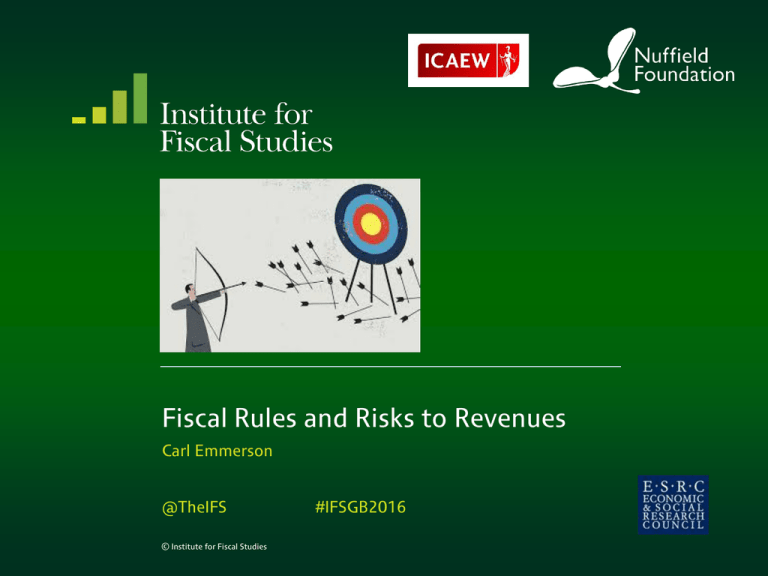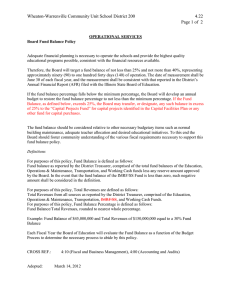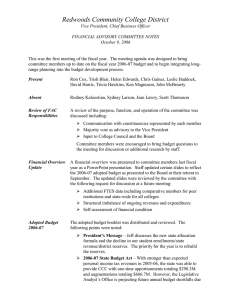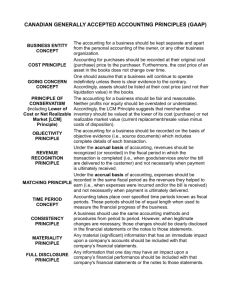Fiscal Rules and Risks to Revenues Carl Emmerson @TheIFS #IFSGB2016
advertisement

Fiscal Rules and Risks to Revenues Carl Emmerson @TheIFS © Institute for Fiscal Studies #IFSGB2016 Eliminating the deficit? Percentage of national income 55 Current receipts Total Managed Expenditure 50 45 Forecast surplus of £10 billion (0.5% of national income) 40 35 © Institute for Fiscal Studies Source: http://budgetresponsibility.org.uk/data/ 2020–21 2019–20 2018–19 2017–18 2016–17 2015–16 2014–15 2013–14 2012–13 2011–12 2010–11 2009–10 2008–09 2007–08 2006–07 2005–06 2004–05 2003–04 2002–03 2001–02 2000–01 30 Three fiscal targets • Reduce public sector net debt as a share of national income every year until a surplus is achieved – selling assets to meet this would be contrary to its underlying principle – forecasts suggest only on course to be met in 2015–16 and 2016–17 due to asset sales • Cap forecast welfare spending – introduced to help Chancellors make unpopular benefit cuts rather than allow spending to increase inappropriately – welfare cap already breached in 2016–17, 2017–18 and 2018–19: not clear it is a real constraint on behaviour • New fiscal mandate: achieve a headline surplus every year from 2019–20, unless growth drops below 1% © Institute for Fiscal Studies Should public sector net debt be reduced? • UK public sector net debt is high compared to: – recent history … but was above 80% of GDP for extended periods prior to 1967 – most advanced economies … although not compared to the largest economies • Good reasons to want to reduce debt as a share of national income: – might provide more fiscal flexibility in the face of another recession – reduce future debt interest commitments © Institute for Fiscal Studies Public sector net debt projections % of national income 90 Out-turn 80 70 Forecast 60 50 Borrowing 1.5% GDP, expected growth 40 30 Borrowing 0% GDP, expected growth 20 Surplus 0.5% GDP, expected growth 10 1974–75 1979–80 1984–85 1989–90 1994–95 1999–00 2004–05 2009–10 2014–15 2019–20 2024–25 2029–30 2034–35 2039–40 2044–45 2049–50 2054–55 2059–60 2064–65 0 Financial year © Institute for Fiscal Studies Notes and sources: see Figure 3.4 of The IFS Green Budget: February 2016. Achieving and maintaining a budget surplus would be a break from the past © Institute for Fiscal Studies 1948 1950 1952 1954 1956–57 1958–59 1960–61 1962–63 1964–65 1966–67 1968–69 1970–71 1972–73 1974–75 1976–77 1978–79 1980–81 1982–83 1984–85 1986–87 1988–89 1990–91 1992–93 1994–95 1996–97 1998–99 2000–01 2002–03 2004–05 2006–07 2008–09 2010–11 2012–13 2014–15 % of national income Achieving and maintaining a budget surplus would be a break from the past 12 10 8 6 4 2 0 -2 -4 -6 Periods of surplus Financial year © Institute for Fiscal Studies Notes and sources: see Figure 3.1 of The IFS Green Budget: February 2016. Should we run budget surpluses? • Debt as a share of national income will fall if debt grows less quickly than the economy – little economic difference between a small budget surplus and a small budget deficit – as long as does not harm growth, smaller deficit / greater surplus would lead to debt falling more quickly • Several potentially good reasons to borrow – investment spending – output stabilisation – adjust gradually to shocks – forecast errors – tax rate smoothing © Institute for Fiscal Studies The Chancellor’s fiscal mandate • Achieve a headline surplus from 2019–20, unless at any point growth over four quarters … – … appears to have been below 1% in the last year – … or is forecast to be below 1% • Fiscal mandate is easy to understand and transparent © Institute for Fiscal Studies The 1% escape clause 4Q-on-4Q rolling growth rate (%) 8 6 4 2 0 -2 -4 © Institute for Fiscal Studies Notes and sources: see Figure 3.6 of The IFS Green Budget: February 2016. 2015 2010 2005 2000 1995 1990 1985 1980 1975 1970 1965 1960 1955 -6 Three problems with the fiscal mandate • Unless we aim consistently for large budget surpluses, significant chance sharp adjustments will be necessary – greater than one-in-four chance that deficit in coming year more than 0.5% of national income greater than expected • Rule might not allow government to respond to lower interest rates with more investment spending – optimal level of borrowing will almost certainly depend, at least in part, on the interest rate • 1% threshold arbitrary, and could increase politicisation of the OBR’s growth forecasts – history suggests growth not often around 1%, but the future might not look like the past © Institute for Fiscal Studies Risks • Many risks around public finance forecasts – spending and revenues under announced policy will differ from forecast – further policy changes will be made • Perhaps most obvious uncertainty around the underlying public finances is over the size of the economy – Oxford Economics pessimistic scenario has GDP 0.7% lower than the OBR forecasts in 2019–20 – this would likely be sufficient to eliminate the forecast surplus • Other factors matter too: including composition and distribution of GDP, oil prices, asset prices, etc. © Institute for Fiscal Studies Risks to underlying revenues • Earnings and employment – directly affect PAYE income tax and National Insurance (£262bn) © Institute for Fiscal Studies Risks: income tax and NICs revenues vulnerable to earnings and employment growth Earnings Index (2010–11 = 100) 135 Nov 10 Nov 11 Dec 12 Dec 13 Dec 14 Nov 15 130 125 120 Employment 200 190 180 170 160 150 115 140 110 130 120 105 110 © Institute for Fiscal Studies Notes and sources: see Figures 5.2 & 5.3 of The IFS Green Budget: February 2016. 2020–21 2019–20 2018–19 2017–18 2016–17 2015–16 2014–15 2013–14 2012–13 2011–12 2010–11 2020–21 2019–20 2018–19 2017–18 2016–17 2015–16 2014–15 2013–14 2012–13 2011–12 100 2010–11 100 Risks to underlying revenues • Earnings and employment – directly affect PAYE income tax and National Insurance (£262bn) • Volume of residential property transactions – affect revenues from stamp duty land tax (£8bn) © Institute for Fiscal Studies Risks: stamp duty revenues vulnerable to residential property market Nov 10 Nov 11 Dec 12 Dec 13 Dec 14 Nov 15 180 160 140 200 180 160 140 120 120 100 100 80 80 © Institute for Fiscal Studies Residential property transactions 2008–09 2009–10 2010–11 2011–12 2012–13 2013–14 2014–15 2015–16 2016–17 2017–18 2018–19 2019–20 2020–21 Residential property prices 2008–09 2009–10 2010–11 2011–12 2012–13 2013–14 2014–15 2015–16 2016–17 2017–18 2018–19 2019–20 2020–21 Index (2008–09 = 100) 200 Notes and sources: see Figures 5.7 & 5.8 of The IFS Green Budget: February 2016. Risks to underlying revenues • Earnings and employment – directly affect PAYE income tax and National Insurance (£262bn) • Volume of residential property transactions – affect revenues from stamp duty land tax (£8bn) • Oil prices – falls directly depress revenues from North Sea oil and gas production – but OBR estimates this is slightly more than offset by increases in revenues from fuel duties and taxes on increased onshore activity © Institute for Fiscal Studies North Sea oil prices and revenues Forecast receipts from offshore taxes downgraded by £3.7bn in 2015–16 90 Price in pounds 80 Forecast, Mar 14 £ per barrel 70 Forecast, Nov 15 60 50 40 30 20 10 © Institute for Fiscal Studies Notes and sources: see Figure 5.10 of The IFS Green Budget: February 2016. 2019 2017 2015 2013 2011 2009 2007 2005 2003 2001 1999 1997 1995 1993 1991 1989 1987 0 Risks to underlying revenues • Earnings and employment – directly affect PAYE income tax and National Insurance (£262bn) • Volume of residential property transactions – affect revenues from stamp duty land tax (£8bn) • Oil prices – falls directly depress revenues from North Sea oil and gas production – but OBR estimates this is slightly more than offset by increases in revenues from fuel duties and taxes on increased onshore activity • Equity prices – falls directly depress revenues from capital taxes (£14bn) – further loss from personal and corporate taxes related to the performance of the financial sector © Institute for Fiscal Studies FTSE All-Share Index and capital tax receipts 5000 4500 4000 Index 3500 3000 2500 November July to 2015 November to January 2015: 2016 equityequity pricesprices down downgraded by another 7.4%; by 7.4% in 2020–21; suggests forecast capital capital tax receipts tax receipts downdown another by £2bn Actual OBR forecast July 2015 OBR forecast November 2015 Latest projection 2000 1500 1000 500 1972 1974 1976 1977 1979 1981 1983 1985 1987 1989 1991 1993 1995 1997 1999 2001 2003 2005 2007 2009 2011 2013 2015 2017 2019 2021 0 © Institute for Fiscal Studies Notes and sources: see Figure 5.9 of The IFS Green Budget: February 2016. Risk to revenues from promised tax cuts • Income tax cuts – Conservative Party manifesto commits to a personal allowance of £12,500 and a higher-rate threshold of £50,000 by April 2020 – standard indexation would increase these to £11,900 and £46,100 – increasing them to £12,500 and £50,000 would cost around £8 billion © Institute for Fiscal Studies Risks to revenues from more generous uprating • Indexation of fuel duty rates – forecasts assume rates will be increased in line with the RPI every year from this April – but rates have not increased in nominal terms since April 2011 – cash freeze would reduce revenues by £3 billion in 2020–21 • Some other thresholds are frozen in cash terms which might not prove sustainable – 40% more additional rate taxpayers since April 2010 due to £150,000 threshold being frozen – 50% increase projected over next five years in numbers losing some or all of their child benefit due to the £50,000 threshold being frozen © Institute for Fiscal Studies Risk to revenues from pensions tax reform • Income tax relief given on (most) pension contributions, while (most) pension withdrawals subject to income tax • Chancellor to announce in Budget whether to retain status quo or whether to implement one of two radical reforms: 1. move to flat-rate income tax relief on contributions, with tax treatment of pension income unchanged 2. income tax levied on pension contributions not pension income • Major reform could have significant and complicated impact on the level and timing of tax revenues – budget surplus in 2019–20 could be achieved with temporary revenues – but this would be contrary fiscal mandate’s underlying principle © Institute for Fiscal Studies Fiscal Rules and Risks to Revenues Carl Emmerson @TheIFS © Institute for Fiscal Studies #IFSGB2016





